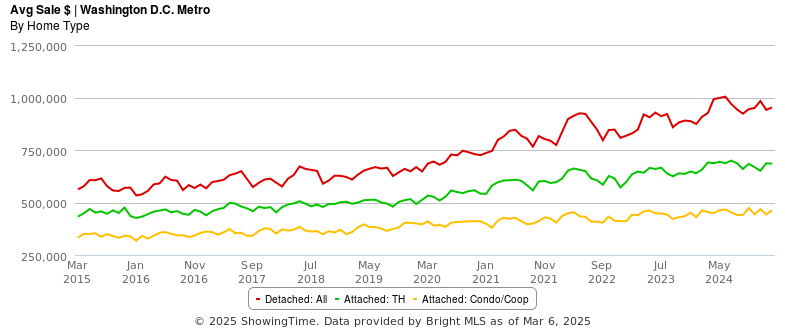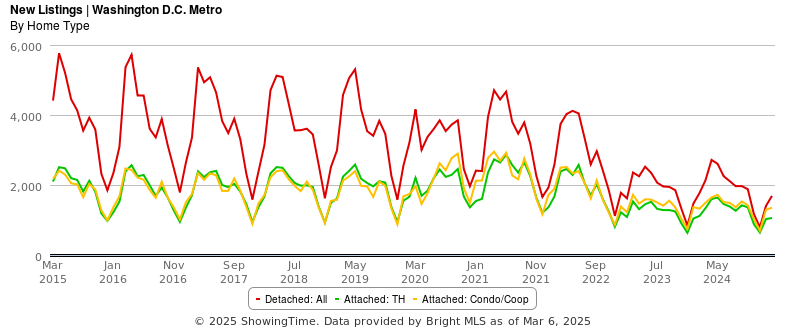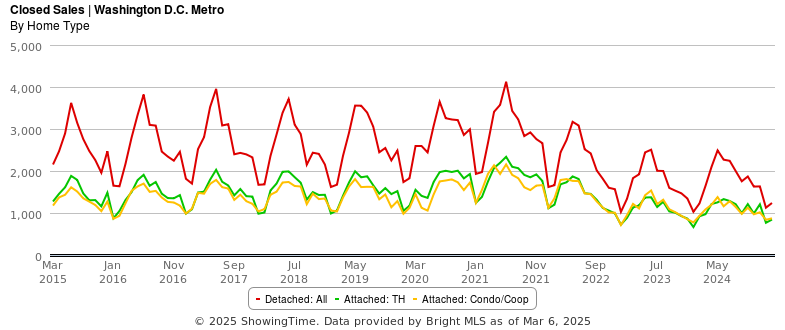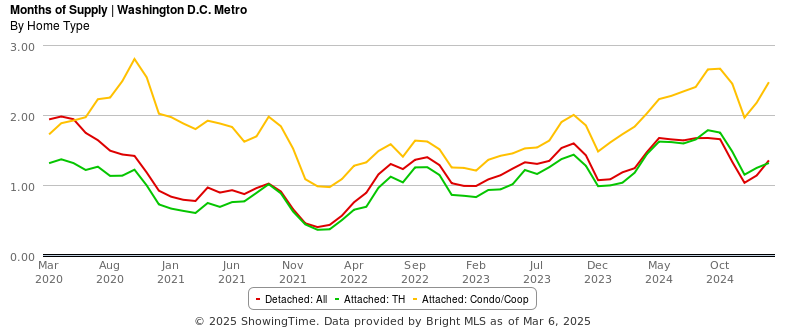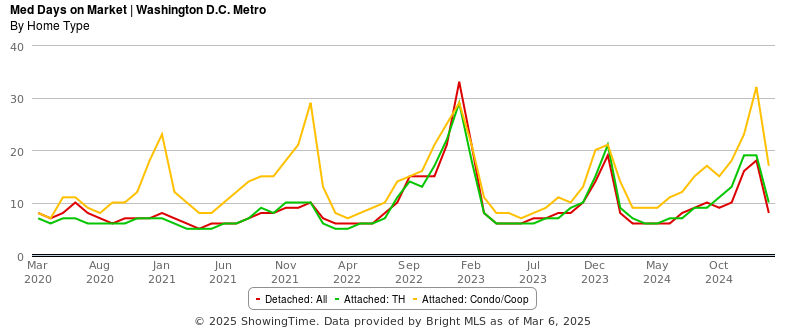Hello, friends! Welcome to the March 2025 Housing Report for the DC Metro area. Today we’re diving into what the local real estate market is doing right now, how new federal policies and DOGE’s budget cuts are shaping the market, and what this means for buyers, sellers, and investors as we head into spring. Plus, if you’re serious about making a move this year, sign up for one of our brunch consults where we meet with you personally over brunch to talk about your individual needs and goals and advise you on how to make the best real estate move in the future. More details on that at the end of the video.
Let’s jump into the numbers to see what’s actually happening and then we’ll talk about DOGE:
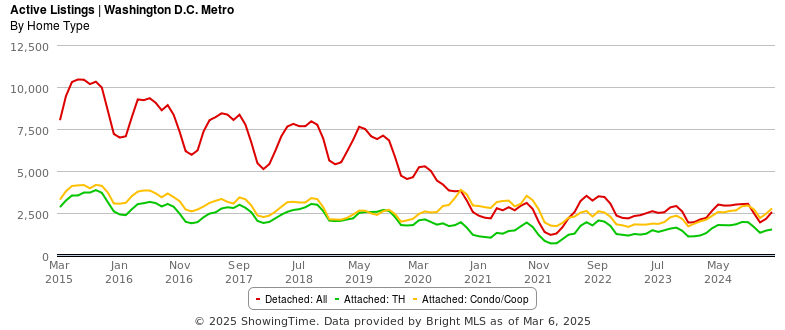
The number of homes for sale ticked up slightly last month. This is interesting because while inventory is still well below historical norms, the number of active listings is actually up 29% year over year. So, compared to historical averages, we’re still low—but compared to last year, we’re seeing a noticeable increase. Now, the market has been hot for years, and we still need more inventory to meet demand—especially in sought-after neighborhoods. So why are we seeing more homes for sale now? Is it because of DOGE? That seems to be the question everyone is asking these days… and we’ll dive into that.
If inventory is rising, does that mean prices are dropping?
Actually, no. Despite the increase in listings, average home prices went up last month. The increase was modest, but it tells us that those shocking headlines about the market crashing don’t reflect reality.
February saw a typical seasonal increase in new listings across all home types—condos, attached, and detached homes. While inventory is still lower than what’s needed, we’re starting to see sellers enter the market ahead of spring, as they usually do.
Interestingly, across the entire DC metro area, new listings were actually 2% lower than last year at this time.
The number of homes sold last month was low, which is normal for this time of year. February historically sees fewer closings, but we expect a big surge in market activity heading into spring. And we’re already seeing that! Right now, we have 10 homes under contract set to close in March, which is pretty strong for early spring.
Overall, single-family homes and townhouses remain solidly in a seller’s market. Condos are holding steady overall, but there’s a clear divide – In the suburbs, condos are performing well.
In DC, condos are struggling. DC condos are currently oversupplied and firmly in a buyer’s market. After what seemed like a promising dip in December, supply has been steadily rising since the new year. This increase in condos for sale could create some excellent buying opportunities in DC over the next year.
Homes are still selling at a competitive pace, with the average home going under contract in 10 days.
And overall, homes are still selling right at about 100% of the asking price for single-family and townhomes, with condos coming in slightly below. So while DC condos may be softening, across the broader market, we’re not seeing major signs of price declines.
Alright, let’s talk about what’s on everyone’s mind—how are Elon and DOGE’s cuts shaking up the DC real estate market?
If you’ve been following the news, you know the Department of Government Efficiency (DOGE) has been busy. Since the start of the year, they’ve slashed $105 billion in spending, shut down 748 federal office leases, and let go of 62,000 federal employees nationwide—with another 100,000 expected to retire or take buyouts. So, what does that mean for DC homeowners and buyers? Let’s break it down:
Here’s What’s Happening Right Now:
- Uncertainty is the big story. USAID has taken a major hit, and people expect more cuts. Government jobs are on the chopping block, and contracts are under review.
- Some federal employees are taking early retirement. That means we could see more homes hitting the market—especially in the suburbs. Buyers, stay alert!
- Less office space = potential shifts in housing demand. With fewer people commuting, or more people commuting! Getting called back to work, but there’s no place to go! We might see ripples in the condo and rental markets as workers rethink where they live.
What’s Actually Happening in the Market: You may have seen articles screaming about “home listings skyrocketing” or “DC home prices slashed!” But let’s look at the real numbers:
- New listings in February? Down 2% compared to last year.
- Home prices in the DC metro area? Up 4.8% year-over-year.
- Prices dipped from August to January—but guess what? They do that every year. And like clockwork, we saw an uptick in February again.
So… Where’s the Flood of Homes? Blame the Boomers! Just kidding. Actually, hats off to them—they worked hard, built equity, and locked in crazy low mortgage rates. They deserve to enjoy their retirement. Here’s why inventory is tight: Most homeowners are sitting on super low interest rates. If you bought a house in 2021, your total 30-year cost is less than half of what it would’ve been if you bought in 1980. People don’t want to trade a 3% mortgage for a 7% one unless they absolutely have to.
So for your consideration, here’s what I see as the impact of DOGE when we look at the numbers. DOGE would like to cut the federal budget by 15% in order to balance it. There are 375,000 jobs (and change) in the DC metro area related to the federal government. Cut 15% of those, and that equates to a cut of 56,000 jobs locally. There are about 5 million people over the age of 18 and it’s estimated that 60% of those people own their home versus rent. That’s 33,800 federal workers that are homeowners. As of 2023 it was estimated that 40% of homeowners have paid off their mortgage. That would equal 20,284 federal workers with a mortgage in the DC Metro Area. If every one of them got laid off and sold their house… We would still be short inventory again in 9 months. Factor in contractors, and the impact might stretch 18 months to 3 years, and that’s not even considering that half of those people with that mortgage have paid off 50% or more of it and are sitting at a 3% interest rate, so that impact could be half that.
But here’s the thing—Fairfax County (one of the biggest suburbs of DC) has an unemployment rate of just 2.5% (compared to the national average of over 4%). This area is one of the best in the country for job opportunities, and not just government jobs – Microsoft, Amazon, Google – they are all putting headquarters here, meaning many layoffs can be absorbed. I’m not saying that’s it’s not a big deal, I’m just saying that these are the numbers and there’s a lot to be positive about.
So, what Should You Do?
Thinking of buying? If you feel good about your job and plan to stay for 5+ years, now is your time to act while others hesitate. The market is still competitive, so let’s make sure we have a great game plan for you.
Thinking of selling and moving out of DC? I would do it sooner rather than later. Demand is still strong, and you can capitalize on a great market before uncertainty may slow things down a little bit.
Finally, if you’re thinking about buying or selling a home and you’re not quite sure what to do, let’s get brunch! It’s on me! We’ll sit down and talk about the market and how it applies to you. If you’re interested, use the QR code on the screen.
Every situation is unique, and we’re here to help you make the best move. Call us today to chat about how this market shift impacts you and how we can get you the best possible result for your future!


